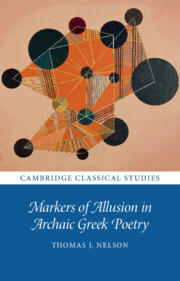The marking of allusion was already deeply engrained in archaic Greek poetics. Phoenix’s introduction of Meleager, with which we began, is but the tip of the iceberg. Epic and lyric poets employed indices of hearsay, memory and time to position themselves within and against their larger tradition, carving out their own distinctive space. What is perhaps most striking and surprising is the extent to which archaic poets employed these devices. The previous chapters have explored numerous cases of indexicality in action: poets gesturing to other traditions and texts, especially as they introduce their references; inviting their audiences to acknowledge competing alternatives or supplement unspoken details; and legitimising their departures from tradition with the veneer of traditional authority. From Homer onwards, archaic poets participated in a sophisticated and well-developed system of allusive indexing. Although they belong to the ‘archaic’ age, there is nothing ‘primitive’ about their poetic practice. This conclusion equally requires us to rethink our understanding of Hellenistic and Roman poets, whose ‘footnoting’ habits are not as novel, bookish or scholarly as we might think.
This book establishes the most forcible case to date for the prominence and prevalence of allusive marking in archaic Greek poetry. It is worth asking why these indices have not been identified or studied at such length before.Footnote 1 A key answer must be our limited and indirect access to many of the traditions behind these references (cf. §i.2.2), alongside underlying scholarly assumptions which have dissuaded us from looking for such indices or interpreting them in the same manner as we would when reading a Hellenistic or Roman poet (cf. §i.1.3). Yet in this study, I have highlighted that such interpretations are in fact possible, plausible and rewarding. Of course, this does not mean that the allusive systems of Greece and Rome were identical or that they remained unchanged for centuries. We have already tracked changes in the nature of intertextuality within the archaic period alone (§i.2). And we have also observed how archaic indices are sometimes less intrusive or metaleptic than their Roman successors (e.g. §iii.2.5), another reason why they might have received less scholarly attention in the past.Footnote 2 But even so, what is striking is how, despite larger developments in allusive practice, indexicality remains a constant. Even as the target of allusion may shift from mythological traditions to specific texts, the very same allusive strategies are employed.
In any case, this argument for continuity should not be mistaken as a claim for uniformity in the use of indexicality throughout archaic poetry. We have focused on three of the most prominent indices of allusion in archaic Greek poetry which feature in both epic and lyric poetry. But we could have also explored others which are less ambidextrous: as we have already noted, the direct naming of other poets is primarily a lyric phenomenon which grows gradually stronger over time (§i.2.3), while the conceptualisation of tradition as fate seems far more dominant in epic narrative (§i.1.4). Even in the case studies that we have considered, we have noted considerable variation in the use of different indices. Hearsay and temporality are prominent throughout archaic epic and lyric, although the differing constructions of the narrator in each corpus result in different emphases, especially in their varyingly direct engagement with poetic πρότεροι. Poetic memory, by contrast, functions in different ways in each genre. In Homeric epic, it primarily features in embedded character speech, while in lyric, it centres around the narratorial voice and its direct address to audiences.
A further detail which we have not yet remarked upon is the variation in the use of the device between different lyric subgenres, especially the apparent scarcity of such indices in archaic iambus. The only examples from this corpus we have explored are the signposting of iambic fable (§ii.3.1) and Archilochus’ internal cross references in his Lycambid song cycle (§iv.3.1). Yet these instances only throw into greater relief the absence of indexicality in iambic allusions to mythical tales. Scholars have plausibly argued for various allusions to epic myth in iambus, especially to the Homeric Odysseus.Footnote 3 But as far as we can see, these were not indexically marked. The fragmentary state of our evidence may again be to blame.Footnote 4 But this balance may also reflect something of iambus’ generic composition and self-perception. The genre appears to have only flagged its engagement with ‘lower’, more popular genres. This contrasts significantly with archaic elegy, which was more concerned with establishing a storehouse of wisdom, and melic lyric, with its focus on myths as exempla for the present. Iambus, by contrast, focused on ainoi, and it is these that the genre indexically marks. What poets indexed, as much as how they did so, is thus illuminating for our understanding of ancient genres and our appreciation of how ancient poets fashioned themselves within their tradition. Our map of archaic indexicality overlaps considerably with – but is not identical to – the overarching map of archaic intertextuality.
Despite these variations, indexicality was a remarkably consistent presence across many archaic texts. Indices of allusion proved a crucial tool for gesturing to the authority of an emerging canon, as poets variously appropriated, challenged and revised tradition. It would be illuminating to extend this study further and explore how such allusive marking continued into Attic drama and prose, corpora where scholars have identified a similar process of (often agonistic) intertextuality.Footnote 5 However, by focusing here on the most controversial period of allusion in the ancient Graeco-Roman world, we have been able to establish a stronger case for continuity. The deep presence of indices in archaic Greek poetry requires us to reconsider the capabilities of archaic poetics and to keep rethinking many established narratives of ancient literary history. From Homer onwards, archaic poets indexed a host of other texts and traditions. In this, as in so many other respects, they marked a path for later generations to follow.

